Peter Wohlleben Quotes & Sayings
Enjoy the top 32 famous quotes, sayings and quotations by Peter Wohlleben.
Famous Quotes By Peter Wohlleben

So many questions remain unanswered. Perhaps we are poorer for having lost a possible explanation or richer for having gained a mystery. But aren't both possibilities equally intriguing? — Peter Wohlleben

Trees, it turns out, have a completely different way of communicating: they use scent. — Peter Wohlleben

The rate of photosynthesis is the same for all the trees. The trees, it seems, are equalizing differences between the strong and the weak. — Peter Wohlleben

My hope is that the wolves' stewardship of natural processes in Yellowstone will help people appreciate the complex ways that trees interact with their environment, how our interactions with forests affect their success, and the role forests play in making our world the kind of place where we want to live. Apart from that, forests hide wonders that we are only just beginning to explore. I invite you to enter my world. — Peter Wohlleben
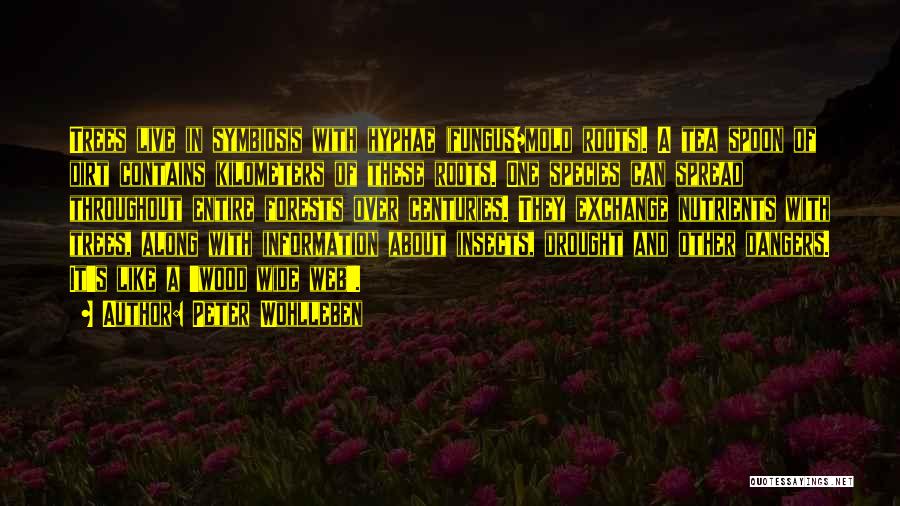
Trees live in symbiosis with hyphae (fungus/mold roots). A tea spoon of dirt contains kilometers of these roots. One species can spread throughout entire forests over centuries. They exchange nutrients with trees, along with information about insects, drought and other dangers. It's like a 'wood wide web'. — Peter Wohlleben

So, in the case of trees, being old doesn't mean being weak, bowed, and fragile. Quite the opposite, it means being full of energy and highly productive. This means elders are markedly more productive than young whippersnappers, and when it comes to climate change, they are important allies for human beings. — Peter Wohlleben

It seems the trees can count! They wait until a certain number of warm days have passed, and only then do they trust that all is well and classify the warm phase as spring. But warm days alone do not mean spring has arrived. — Peter Wohlleben
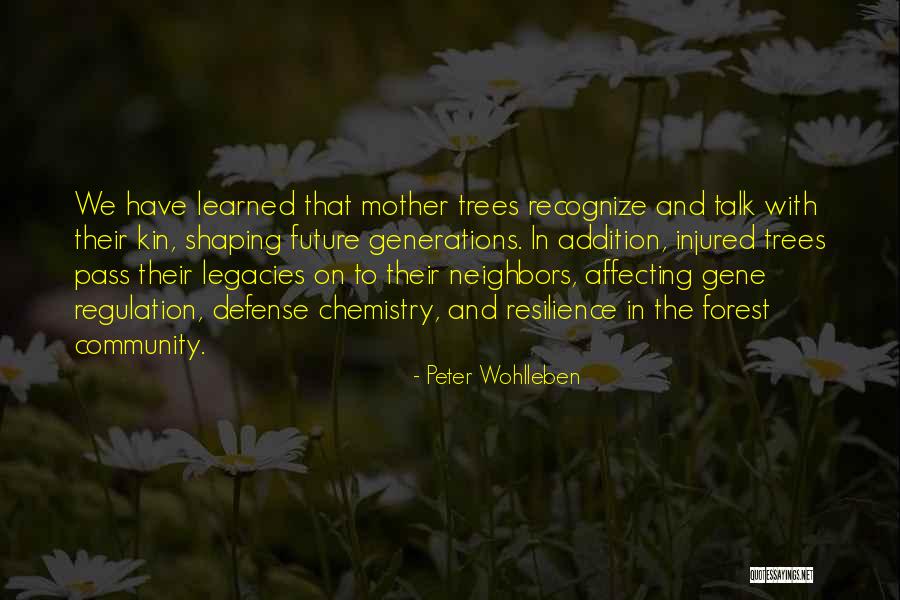
We have learned that mother trees recognize and talk with their kin, shaping future generations. In addition, injured trees pass their legacies on to their neighbors, affecting gene regulation, defense chemistry, and resilience in the forest community. — Peter Wohlleben
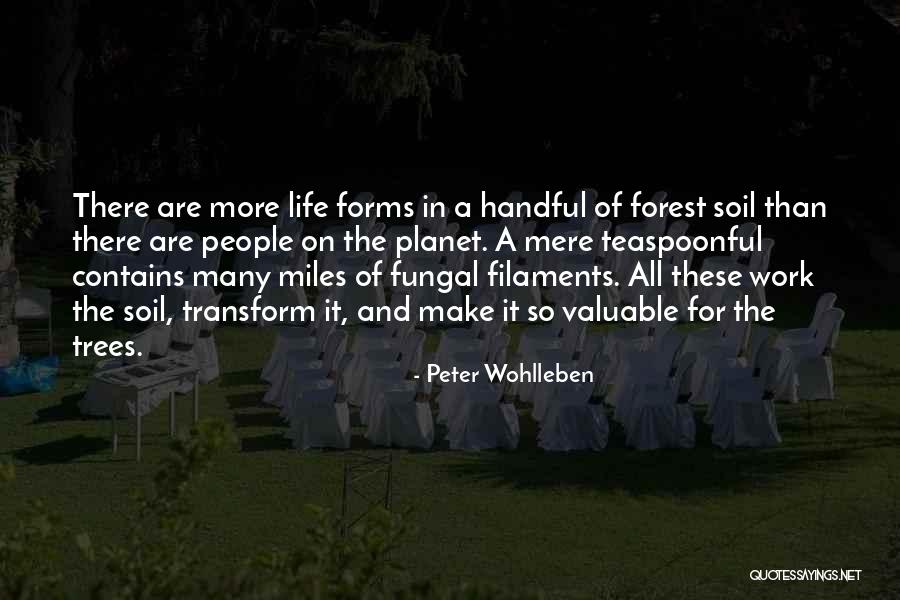
There are more life forms in a handful of forest soil than there are people on the planet. A mere teaspoonful contains many miles of fungal filaments. All these work the soil, transform it, and make it so valuable for the trees. — Peter Wohlleben
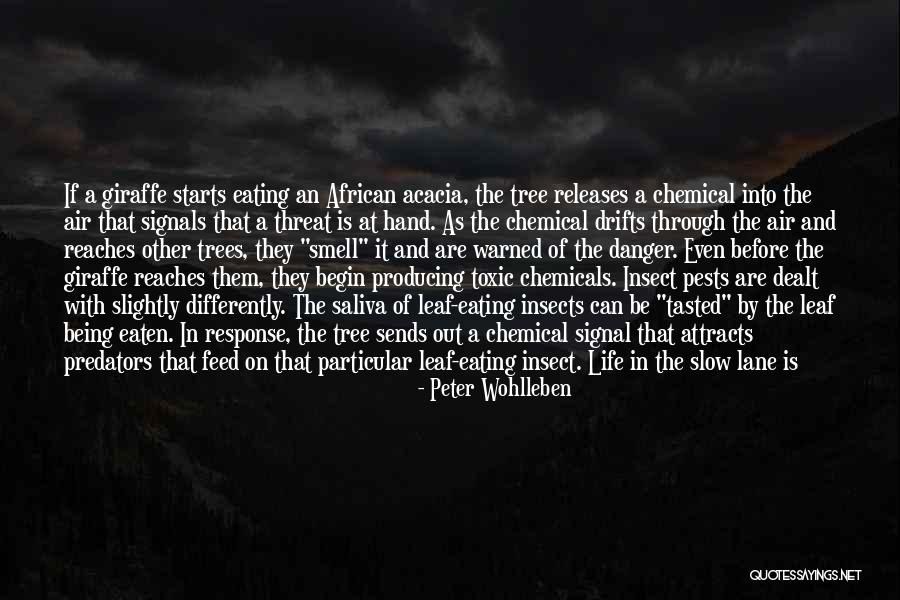
If a giraffe starts eating an African acacia, the tree releases a chemical into the air that signals that a threat is at hand. As the chemical drifts through the air and reaches other trees, they "smell" it and are warned of the danger. Even before the giraffe reaches them, they begin producing toxic chemicals. Insect pests are dealt with slightly differently. The saliva of leaf-eating insects can be "tasted" by the leaf being eaten. In response, the tree sends out a chemical signal that attracts predators that feed on that particular leaf-eating insect. Life in the slow lane is clearly not always dull. But — Peter Wohlleben
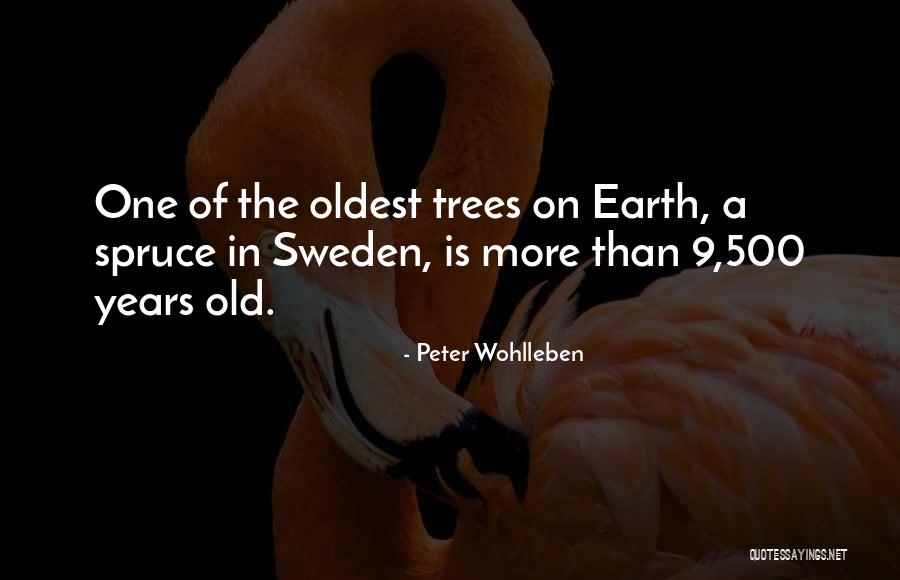
One of the oldest trees on Earth, a spruce in Sweden, is more than 9,500 years old. — Peter Wohlleben
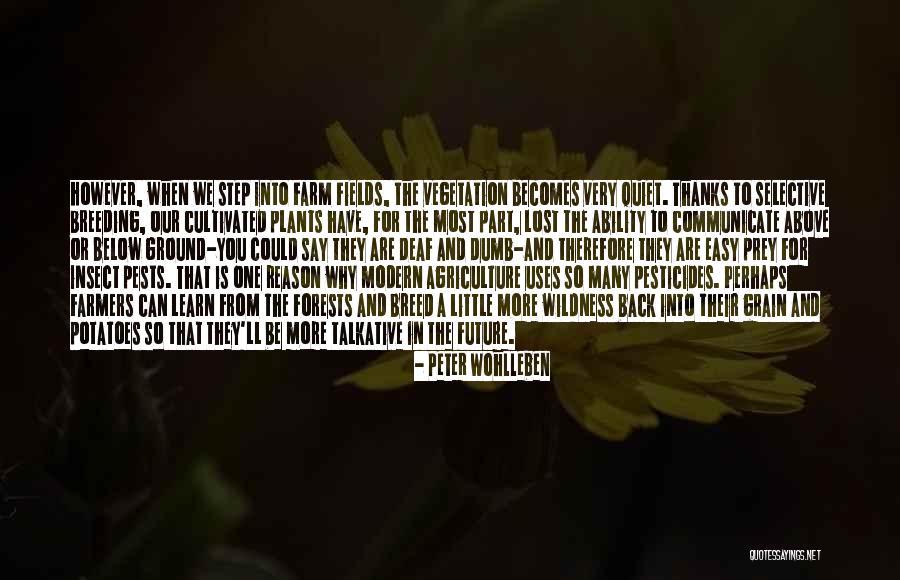
However, when we step into farm fields, the vegetation becomes very quiet. Thanks to selective breeding, our cultivated plants have, for the most part, lost the ability to communicate above or below ground-you could say they are deaf and dumb-and therefore they are easy prey for insect pests. That is one reason why modern agriculture uses so many pesticides. Perhaps farmers can learn from the forests and breed a little more wildness back into their grain and potatoes so that they'll be more talkative in the future. — Peter Wohlleben
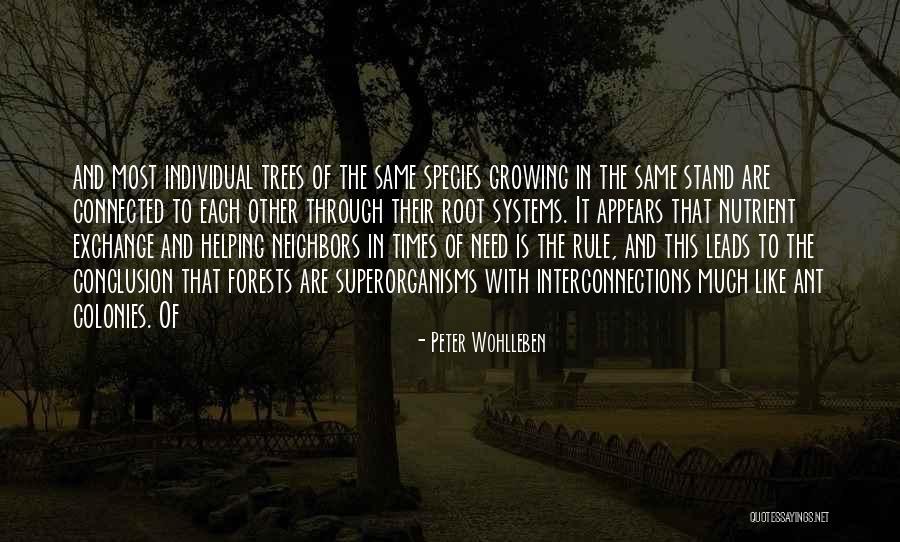
and most individual trees of the same species growing in the same stand are connected to each other through their root systems. It appears that nutrient exchange and helping neighbors in times of need is the rule, and this leads to the conclusion that forests are superorganisms with interconnections much like ant colonies. Of — Peter Wohlleben
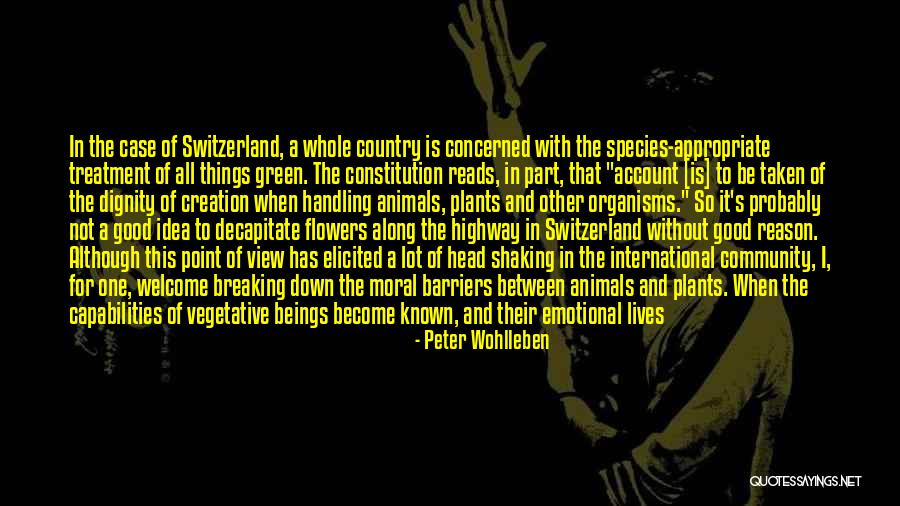
In the case of Switzerland, a whole country is concerned with the species-appropriate treatment of all things green. The constitution reads, in part, that "account [is] to be taken of the dignity of creation when handling animals, plants and other organisms." So it's probably not a good idea to decapitate flowers along the highway in Switzerland without good reason. Although this point of view has elicited a lot of head shaking in the international community, I, for one, welcome breaking down the moral barriers between animals and plants. When the capabilities of vegetative beings become known, and their emotional lives and needs are recognized, then the way we treat plants will gradually change, as well. Forests are not first and foremost lumber factories and warehouses for raw material, and only secondarily complex habitats for thousands of species, which is the way modern forestry currently treats them. Completely the opposite, in fact. — Peter Wohlleben
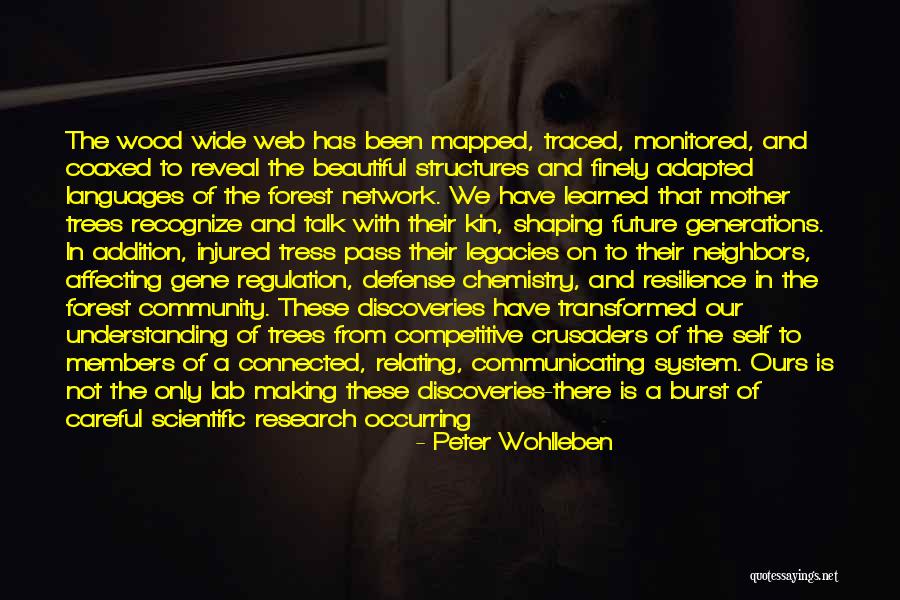
The wood wide web has been mapped, traced, monitored, and coaxed to reveal the beautiful structures and finely adapted languages of the forest network. We have learned that mother trees recognize and talk with their kin, shaping future generations. In addition, injured tress pass their legacies on to their neighbors, affecting gene regulation, defense chemistry, and resilience in the forest community. These discoveries have transformed our understanding of trees from competitive crusaders of the self to members of a connected, relating, communicating system. Ours is not the only lab making these discoveries-there is a burst of careful scientific research occurring worldwide that is uncovering all manner of ways that trees communicate with each other above and below ground. — Peter Wohlleben
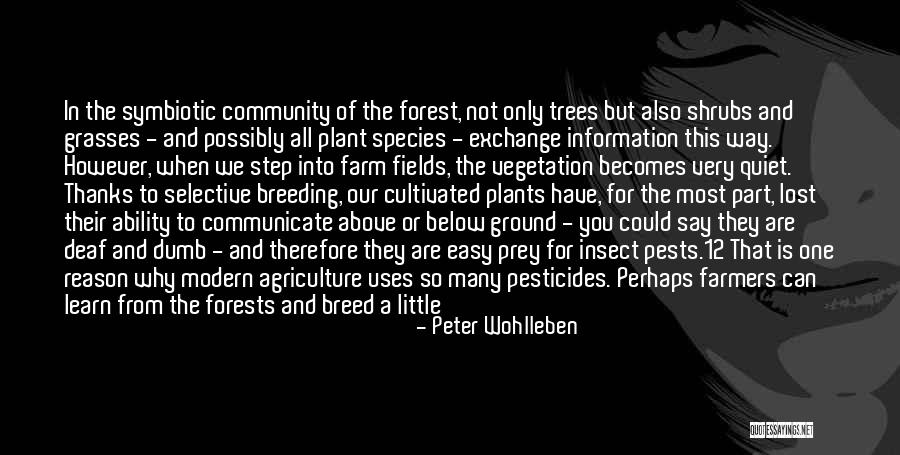
In the symbiotic community of the forest, not only trees but also shrubs and grasses - and possibly all plant species - exchange information this way. However, when we step into farm fields, the vegetation becomes very quiet. Thanks to selective breeding, our cultivated plants have, for the most part, lost their ability to communicate above or below ground - you could say they are deaf and dumb - and therefore they are easy prey for insect pests.12 That is one reason why modern agriculture uses so many pesticides. Perhaps farmers can learn from the forests and breed a little more wildness back into their grain and potatoes so that they'll be more talkative in the future. Communication — Peter Wohlleben

Willows produce the defensive compound salicylic acid, which works in much the same way. But not on us. Salicylic acid, is a precursor of aspirin, and tea made from willow bark can relieve headaches and bring down fevers. Such defense mechanisms, of course, take time. — Peter Wohlleben

Do you know what the most fun moments are? When recent graduates visit us as part of their training. They were taught exactly what the industry wants. They expect a bunch of long haired dreamers who say 'peace'. But on the first evening with them we start with calculating the profits of their models and compare it to our model. Then they realize that what they learned at school is nothing compared to what there is to know. — Peter Wohlleben
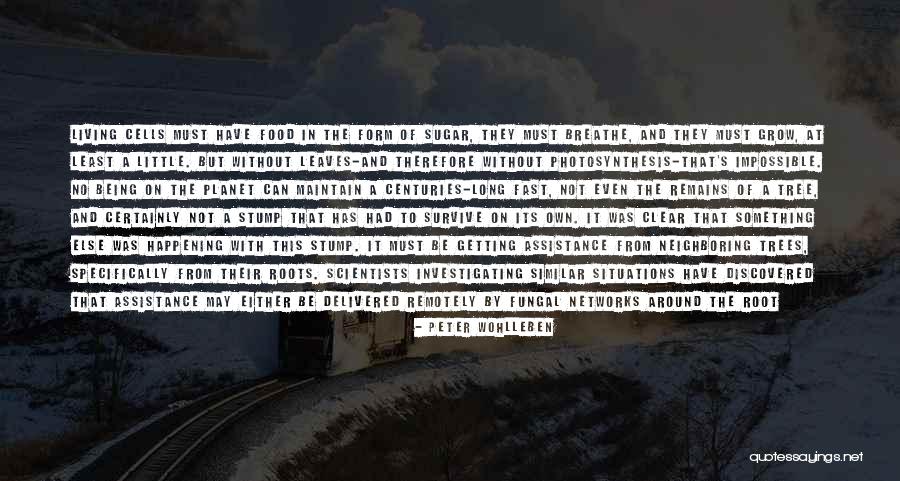
Living cells must have food in the form of sugar, they must breathe, and they must grow, at least a little. But without leaves-and therefore without photosynthesis-that's impossible. No being on the planet can maintain a centuries-long fast, not even the remains of a tree, and certainly not a stump that has had to survive on its own. It was clear that something else was happening with this stump. It must be getting assistance from neighboring trees, specifically from their roots. Scientists investigating similar situations have discovered that assistance may either be delivered remotely by fungal networks around the root tips-which facilitate nutrient exchange between trees-or the roots themselves may be interconnected. In the case of the stump I had stumbled upon, I couldn't find out what was going on, because I didn't want to injure the old stump by digging around it, but one thing was clear: the surrounding beeches were pumping sugar to the stump to keep it alive. — Peter Wohlleben
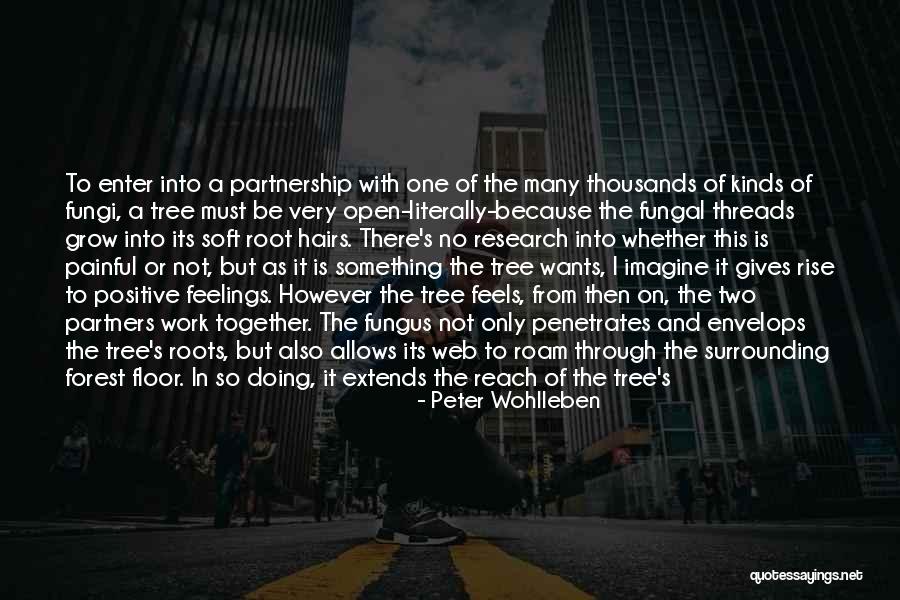
To enter into a partnership with one of the many thousands of kinds of fungi, a tree must be very open-literally-because the fungal threads grow into its soft root hairs. There's no research into whether this is painful or not, but as it is something the tree wants, I imagine it gives rise to positive feelings. However the tree feels, from then on, the two partners work together. The fungus not only penetrates and envelops the tree's roots, but also allows its web to roam through the surrounding forest floor. In so doing, it extends the reach of the tree's own roots as the web grows out toward other trees. Here, it connects with other trees' fungal partners and roots. And so a network is created, and now it's easy for the trees to exchange vital nutrients (see chapter 3, "Social Security") and even information-such as an impending insect attack.
This connection makes fungi something like the forest Internet. — Peter Wohlleben
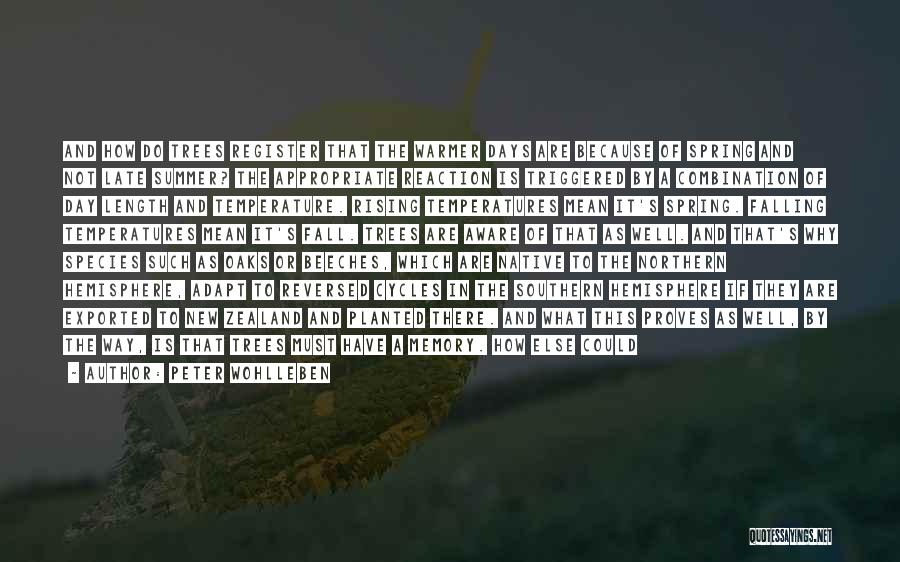
And how do trees register that the warmer days are because of spring and not late summer? The appropriate reaction is triggered by a combination of day length and temperature. Rising temperatures mean it's spring. Falling temperatures mean it's fall. Trees are aware of that as well. And that's why species such as oaks or beeches, which are native to the Northern Hemisphere, adapt to reversed cycles in the Southern Hemisphere if they are exported to New Zealand and planted there. And what this proves as well, by the way, is that trees must have a memory. How else could they inwardly compare day lengths or count warm days? — Peter Wohlleben

A biologist from Leningrad, Boris Tokin, described them like this back in 1956: if you add a pinch of crushed spruce or pine needles to a drop of water that contains protozoa, in less than a second, the protozoa are dead. In the same paper, Tokin writes that the air in young pine forests is almost germfree, thanks to the phytoncides released by the needles. In essence, then, trees disinfect their surroundings. — Peter Wohlleben
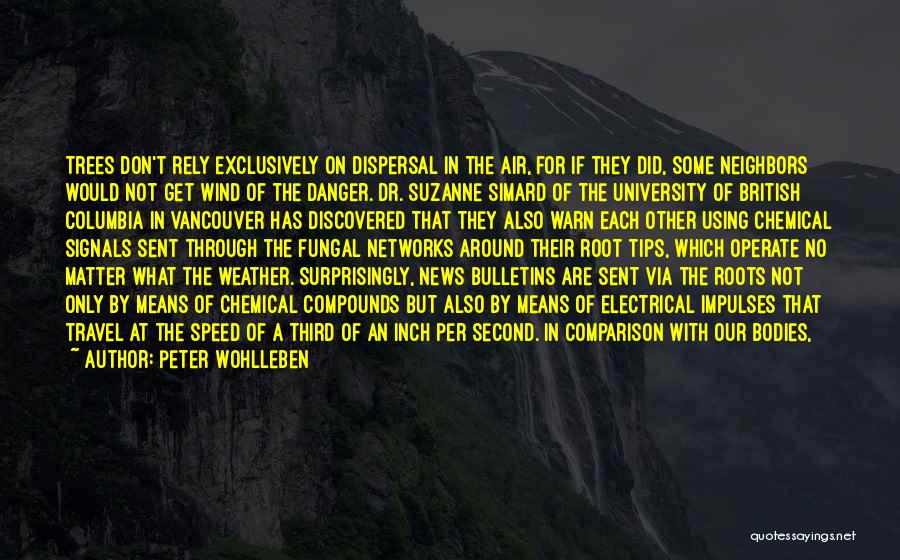
Trees don't rely exclusively on dispersal in the air, for if they did, some neighbors would not get wind of the danger. Dr. Suzanne Simard of the University of British Columbia in Vancouver has discovered that they also warn each other using chemical signals sent through the fungal networks around their root tips, which operate no matter what the weather. Surprisingly, news bulletins are sent via the roots not only by means of chemical compounds but also by means of electrical impulses that travel at the speed of a third of an inch per second. In comparison with our bodies, it is, admittedly, extremely slow. However there are species in the animal kingdom, such as jellyfish and worms, whose nervous systems conduct impulses at similar speed. Once the latest news has been broadcast, all oaks int he area promptly pump tannins through their veins. — Peter Wohlleben
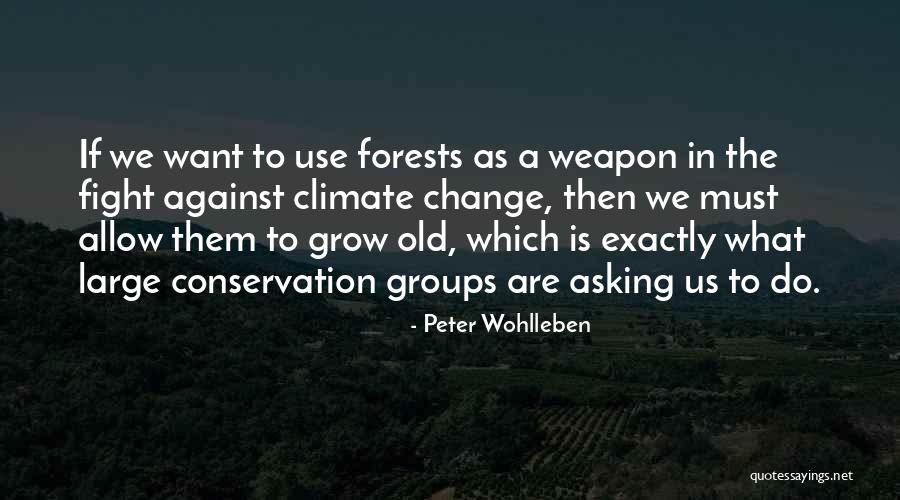
If we want to use forests as a weapon in the fight against climate change, then we must allow them to grow old, which is exactly what large conservation groups are asking us to do. — Peter Wohlleben
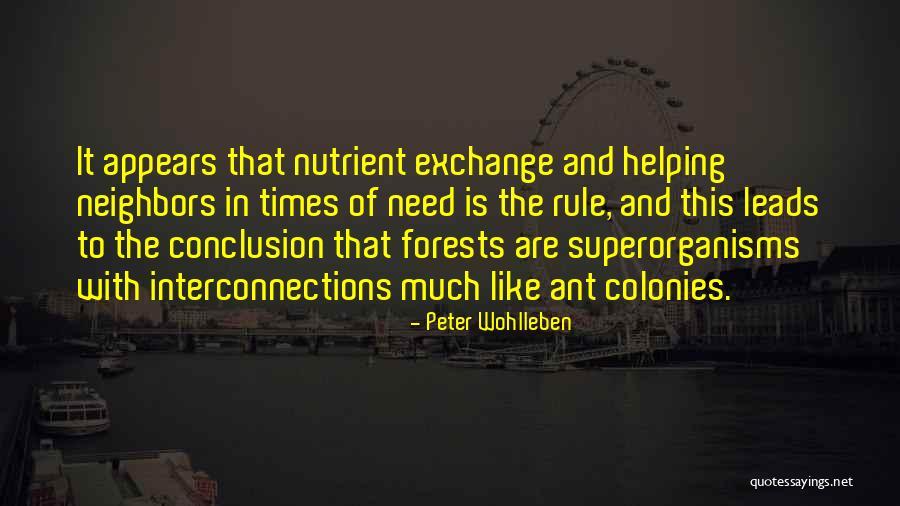
It appears that nutrient exchange and helping neighbors in times of need is the rule, and this leads to the conclusion that forests are superorganisms with interconnections much like ant colonies. — Peter Wohlleben
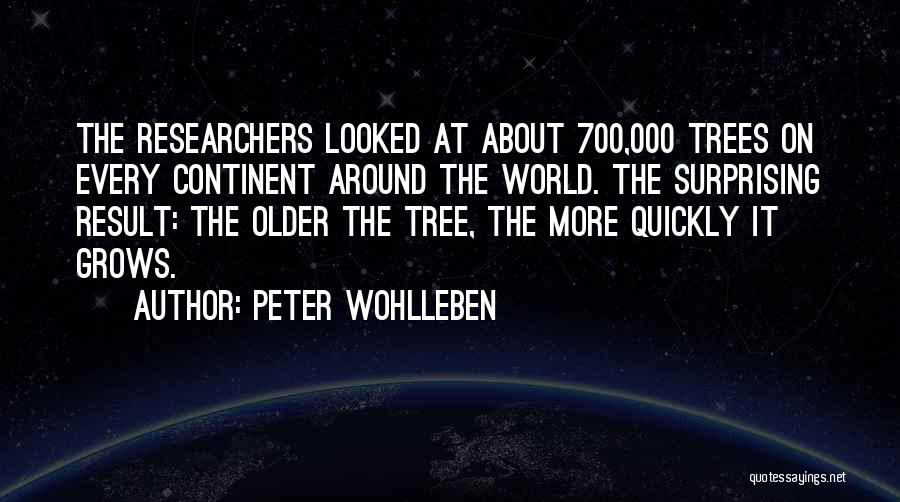
The researchers looked at about 700,000 trees on every continent around the world. The surprising result: the older the tree, the more quickly it grows. — Peter Wohlleben
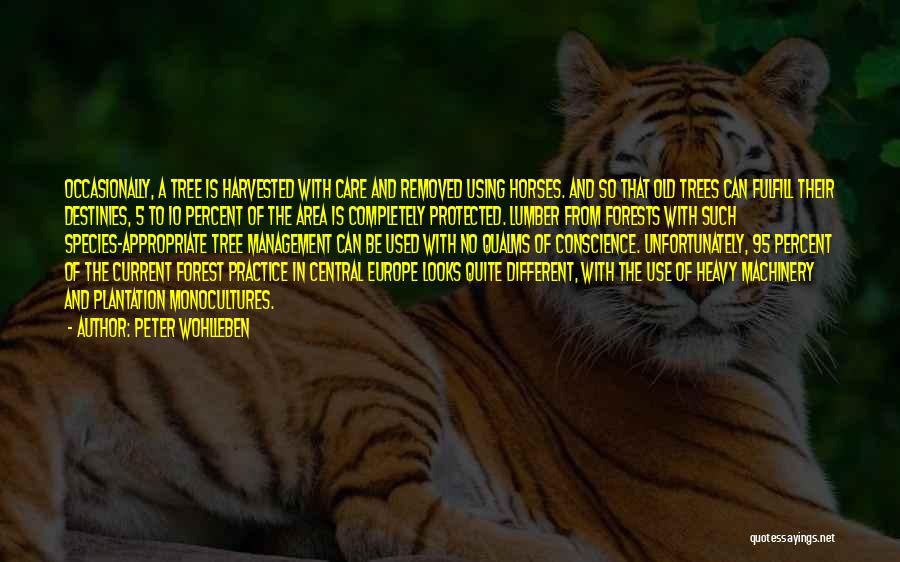
Occasionally, a tree is harvested with care and removed using horses. And so that old trees can fulfill their destinies, 5 to 10 percent of the area is completely protected. Lumber from forests with such species-appropriate tree management can be used with no qualms of conscience. Unfortunately, 95 percent of the current forest practice in Central Europe looks quite different, with the use of heavy machinery and plantation monocultures. — Peter Wohlleben

Chief Marilyn Slett, president of Coastal First Nations, is well aware of the forest's importance: "Our leaders understand our well being is connected to the well being of our land and waters...If we use our knowledge and our wisdom to look after [them], they will look after us into the future." The Kichiwa of Sarayaku, Ecuador, see their forest as "the most exalted expression of life itself. — Peter Wohlleben
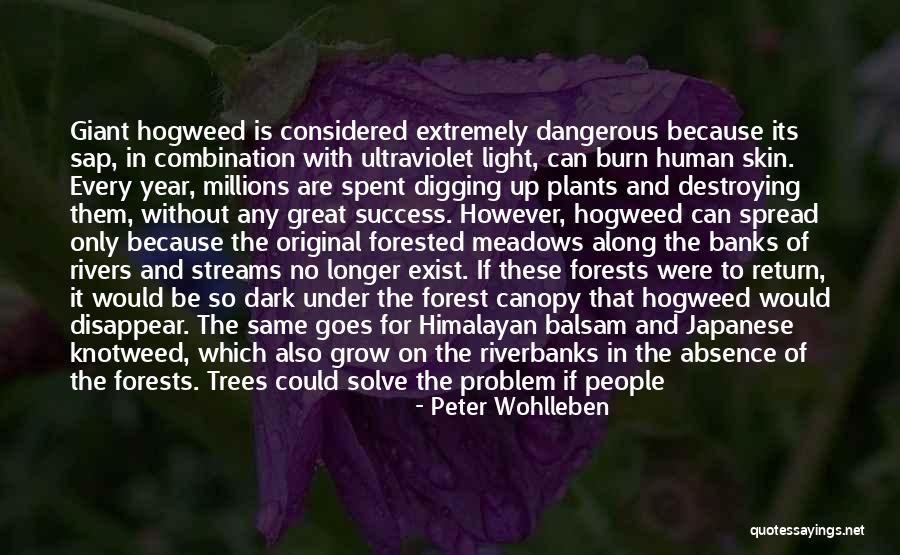
Giant hogweed is considered extremely dangerous because its sap, in combination with ultraviolet light, can burn human skin. Every year, millions are spent digging up plants and destroying them, without any great success. However, hogweed can spread only because the original forested meadows along the banks of rivers and streams no longer exist. If these forests were to return, it would be so dark under the forest canopy that hogweed would disappear. The same goes for Himalayan balsam and Japanese knotweed, which also grow on the riverbanks in the absence of the forests. Trees could solve the problem if people trying to improve things would only allow them to take over. — Peter Wohlleben

The real question is whether we help ourselves only to what we need from the forest ecosystem, and - analogous to our treatment of animals - whether we spare the trees unnecessary suffering when we do this. T — Peter Wohlleben
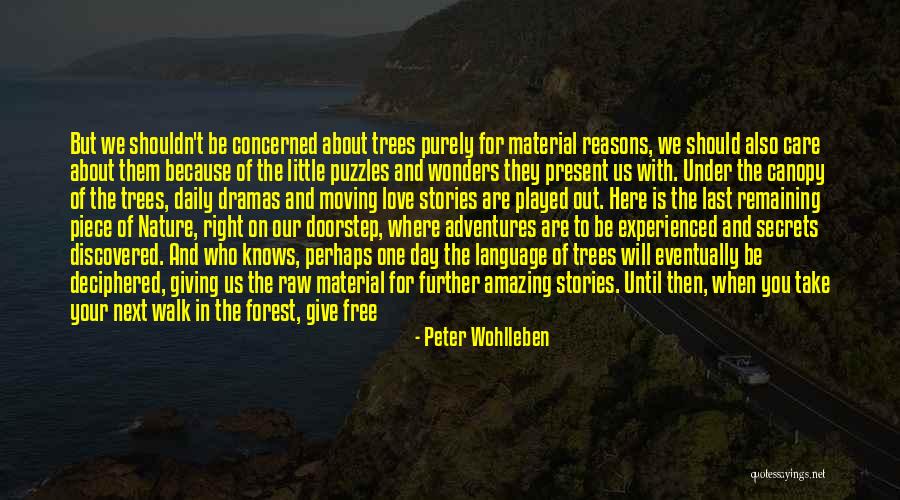
But we shouldn't be concerned about trees purely for material reasons, we should also care about them because of the little puzzles and wonders they present us with. Under the canopy of the trees, daily dramas and moving love stories are played out. Here is the last remaining piece of Nature, right on our doorstep, where adventures are to be experienced and secrets discovered. And who knows, perhaps one day the language of trees will eventually be deciphered, giving us the raw material for further amazing stories. Until then, when you take your next walk in the forest, give free rein to your imagination-in many cases, what you imagine is not so far removed from reality, after all! — Peter Wohlleben
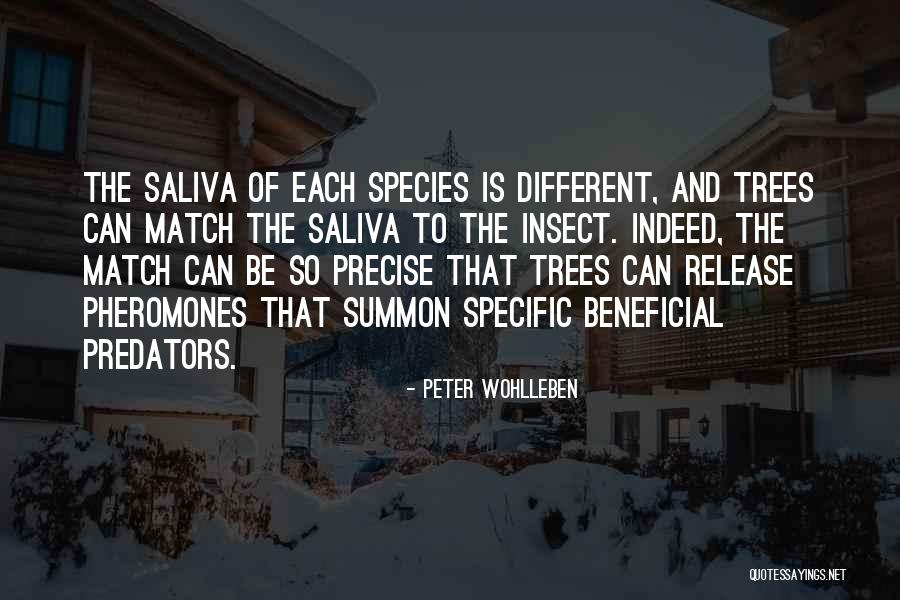
The saliva of each species is different, and trees can match the saliva to the insect. Indeed, the match can be so precise that trees can release pheromones that summon specific beneficial predators. — Peter Wohlleben





